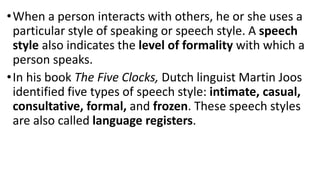The document discusses various speech styles and their characteristics, as identified by linguists such as Martin Joos and Ronald Wardhaugh. It categorizes speech styles into five types: intimate, casual, consultative, formal, and frozen, each varying by context and formality level. Factors like audience and relationship influence the choice of speech style, with specific characteristics for each type explained in detail.





























